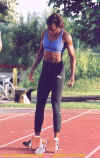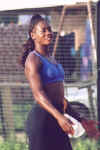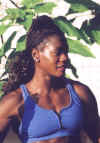|
Podrobnosti
o odločitvi glede Merlene Ottey
 7
Julij 2000 - Monte Carlo - Ponovno odkritje "škodljivega
nandrolona" pri jamajški atletinji Merlene Ottey in stališča
posebne arbitraže pri IAAF glede tega, so povzročile mnoge špekulativne
zapise v medijih, prav tako pa zahteve po podrobnejših
informacijah od obeh "vpletenih" strani, članic
mednarodne atletske družine. Zato da bi bila javnost pravilno
informirana in zadeva transparentna, se je IAAF odločila javno
objaviti polno besedilo odločitve posebne arbitražne komisije,
ki je v skladu z določili ustnovnih aktov IAAF dokončna in
obvezujoča za obe strani. 7
Julij 2000 - Monte Carlo - Ponovno odkritje "škodljivega
nandrolona" pri jamajški atletinji Merlene Ottey in stališča
posebne arbitraže pri IAAF glede tega, so povzročile mnoge špekulativne
zapise v medijih, prav tako pa zahteve po podrobnejših
informacijah od obeh "vpletenih" strani, članic
mednarodne atletske družine. Zato da bi bila javnost pravilno
informirana in zadeva transparentna, se je IAAF odločila javno
objaviti polno besedilo odločitve posebne arbitražne komisije,
ki je v skladu z določili ustnovnih aktov IAAF dokončna in
obvezujoča za obe strani.
"V zadevi,
ki jo je vzpodbudila "International Amateur Athletic Federation (IAAF),
(Applicant), je po pravilu IAAF 21 para 3 (ii) v zadevi,
katere udeleženec je članica IAAF, the Jamaican Amateur Athletic Association (JAAA),
(Respondent), opravljeno zaslišanje po praqvilu IAAF Rule 59
"Disciplinski Postopki za kršitve uporabe doping" in IAAF
se zaveda, da je v postopku in svoji zaključkih tega zaslišanja
storila napake in prišla do napačnih zaključkov ali bila
zavedena.
Kjer:
- Sme spor med članico
in predsedstvom (vodstvom) IAAF biti posredovan arbitražni
komisiji (Arbitration Panel) v zadevah o katerih je članica Member
opravila zaslišanje po pravilu "Rule 59" glede kršitve
uporabe dopinga in kadar je IAAF , da je članica IAAF v
svojih psotopki naredila napako ali prišla do napačnih
zaključkov (Rule 21 para. 3
(ii));
- JAAA je članica
IAAF in je opravila zaslišanje v primeru Merlene Ottey in
samo pravila IAAF so v tem primeru, ko je bil opravljen doping
test, veljavna pravila.
- Svioja stališča
v podporo "Reference" z dne 29. aprila 2000 (pismo z
datumom 4. maj
2000) je Svet IAAF predal zadevo - odločitev JAAA z dne 7.
decembra 1999, s katerim s ooprostili Merlene Ottey obtožbe
jemanja poživil, Arbitražnemu odboru IAAF. Njihova odločitev
je temeljila na na zaključkih, da predhodno podana strokovna
mnenja ne podpirajo trditve, da naj bi zaužila prepovedan poživila
(metabolične substance, ki so jih našli v vzorcih urina) -
skladno s temi ugoovitvam, tribunal JAAA ni bil prepričan, da
je Merlene ta sredstva sama vnesla v telo, temveč da jih je
"proizvedlo" njeno telo.
Sedaj smo: Christoph Vedder,
predsednik, Monty
Hacker in sodnik James Murphy
imenovani s strani IAAF arbitri v omenjeni zadevi v skladu z določili
pravilnika IAAF.
 Having taken note of the said Referral to
Arbitration, the Statement of IAAF in Support of its Referral, the
Response of both JAAA (dated 8 June, 2000) and of Ms. Merlene
Ottey (dated 29 May, 2000) and the documents and references in the
bundles collected by both IAAF and JAAA and on behalf of Ms.
Merlene Ottey, Having taken note of the said Referral to
Arbitration, the Statement of IAAF in Support of its Referral, the
Response of both JAAA (dated 8 June, 2000) and of Ms. Merlene
Ottey (dated 29 May, 2000) and the documents and references in the
bundles collected by both IAAF and JAAA and on behalf of Ms.
Merlene Ottey,
po zaslišanju
Merlene Ottey in predstavnikov JAAA dne 16. in 17. junija
2000 in ko smo poslušali predloge sveta IAAF:
 Michael Beloff Q.C.
in pomočnik Mark Gay Esq. ter Ms. Karen Langlois - kot
predstavniki IAAF. Michael Beloff Q.C.
in pomočnik Mark Gay Esq. ter Ms. Karen Langlois - kot
predstavniki IAAF.
Charles Flint Q.C. -predstavnik JAAA
Dr. Lloyd Barnett - predstavniki JAAA
Dr. Stephan Netzle - predstavnik Merlene Ottey
in po zaslišanju
naslednjih ekspertov:
-
predstavnik IAAF:
Dr. Martial Saugy
-
predstavniki Merlene Ottey:
Dr. Simon Davis
Dr. John Honour
sprejeli
naslednjo odoločitev:
- 5. julija 1999,
je Merlene Ottey, atletinja pod jurisdikcijo IAAFopravila
anti-doping test po tekmovanju na mitingu, ki ga je
organizirala Evropska atletska zveza - področna skupina v
Luzernu v Švici. "A" vzorec urina so analizirali v
laboratorijih v Luzernu, akreditiranih pri IOC 9. julija 1999
in ugotovili so prisotnost 19-norandosterone (NA) v
koncentraciji 15ng/ml in 19-noretiocholanolone (NE) iv
koncentraciji 10ng/ml. Ti dve substanci sta metabolida
nandrolona.
- 2. septembra 1999
so v laboratorijih v Lausanni opravili še analize vzorca "B",
vzetega Merlene Ottey. Tem analizam je med drugim pisostvoval
tudi Daniel Zimmermann, ki je predstavljal atletinjo.
Rezultati analize "B" vzorca so prav tako pokazali
prisotnost ± 14ng/ml substance 19-NA in ± 11ng/ml substance 19-NE.
- Rezultati
analize "B" vzorca so torej potrdili analizo vzorca "A"
in zaradi tega je bila Merlene Ottey suspendirana in
predlagana za zaslišanje pred ustreznim Tribunalom JAAA. ta
Ttribunal se je s primerom seznanil 30. novembra 1999. Pisno
poročilo je bilo sestavljeno 2. decembra 1999 in je bilo
uradno ratificirano s strani Izvršnega odbora JAAA 7.
decembra. Ugotovljeno je bilo, da Merlene Ottey ni kršila
pravil glede jemanja nedovoljenih poživil in zato so njen
suspenz umaknili. JAAA je svojo odločitev utemeljila predvsem
z dejstvom, da JAAA ni uspela dokazati, da je vzorec urina, ki
je pokazal pozitivne rezultate, resnično pripradal Merlene
Ottey in da pravila IAAF niso bila eksplicitno kršena -
krivda pa je padla na samo JAAA, ki bi morala dokazati, da je
Merlene omenjene prepovedane substance zares zaužila. Na
podlagi evidence, ki jim je bila na voljo, niso mogli zagotovo
trditi, da bi Merlene Ottey omenjene substance zaužila, ampak
jih je po vsej verjetnosti proizvedlo njeno telo samo.
- Po odločitvi z
dne 12. februarja 2000 je Svet IAAF suspendiral Merlene Ottey
z uporabo pravila 59.2, kot je bilo navedeno.
- Med zaslišanjem
so bile podane številne zahteve in predlogi. Sledeč
ugotovitvam Sveta in upoštevaje predloge, ki so mu bili predočeni,
je Arbitražni odbor izdal naslednjo odločbo, ki upošteva
vsa predhodo navedena dejstva:
- Predlog za
arbitražo, podan s strani IAAF, ki ga je predsednik Arbitražnega
odbora prejel 4. maja 2000, je dopusten.
- Applying the rule of lenity in
favour of the respondent and the athlete the latest
application of the Rule change from 3 to 6 months would be 1
January, 2000, the date of the publication of the new
Handbook. However, the JAAA was aware of the rule change
from three to six months prior to the hearing in December as
shown by their representation at Congress on August 17 –
19, 1999, when the change was adopted as shown by the
Minutes. The rule change was outlined in the IAAF Newsletter
of September 1999, sent to all Member Federations. Under
these circumstances, the Arbitration Panel invokes Rule 21.1
sub para. 2 which allows it to accept the referral
considering it to be fair and reasonable.
- The alleged improper contact between
IAAF and the athlete has no relevance to the issue of the
admissibility and under Rule 55.11 it casts no doubt as to
the reliability of the finding that a prohibited substance
may be present in a sample.
- The point of waiver attributed to
the non-attendance by IAAF at JAAA’s hearing is rejected
as having no substance.
- The Arbitration Panel states that this
is a hearing de novo.
- During evidence, the only persons who
may be present are the parties and their representatives and
in the case of expert evidence, the opposing party’s
experts.
- The Arbitration Panel invites the
parties to address them further if they consider it necessary
on the issue of burden of proof.
- Upon resumption of the hearing, IAAF
applied for an adjournment to secure the attendance of their
expert witnesses. Having considered the arguments put forward
by both parties the Arbitration Panel issued the following
decision:
- The application is denied as far as
the matter of endogenous production is concerned. The issue of
possible endogenous production of nandrolone or its
metabolites was raised in JAAA’s decision of 7 December,
1999 and was addressed in IAAF’s statement in support of the
referral to arbitration dated 29 April, 2000.
- It appears that the issues of
"innocent substances" and the interaction of several
causes, have not been previously addressed and therefore, if
the Respondent wishes to adduce evidence on the subject, the
IAAF will be afforded a postponement to allow to respond.
The Respondent and the representative
of Ms Ottey declared that they do not continue to rely on the
subject matter of "innocent substances" understood by
common agreement as substances taken through exogenous
administration.
- At the continued hearing, IAAF made an
application to allow Prof. Hemmersbach to give testimony by
the production of a paper he had written himself and by means
of a telephone conference. The Arbitration Panel dismissed the
application.
- The respondent and Merlene Ottey’s
Counsel went on record and stipulated to acknowledge the chain
of custody, the propriety of the collection procedure, the
testing of the sample and the findings of the laboratory in
respect thereof as well as the identification of the source of
the sample as derived from Ms. Ottey. The parties agreed that
the specific gravity readings and the nanogramme readings and
the laboratory reports for the "A" and "B"
samples were not disputed. What was challenged was the method
of interpretation of these readings, regard being had to the
degree of degradation of the samples between the times of
voiding and the "A" and "B" sample
laboratory analyses respectively.
- In terms of Rule 55.2
(i) as read with
Rule 60.1 (i) a doping offence occurs when a prohibited
substance is found to be present in an athlete’s body
tissues or fluids.
- Nandrolone and its chemically or
pharmacologically related compounds is a prohibited substance
as provided for in Rule 55.3 as read with Schedule 1, Part
I(a)(i) of the Procedural Guidelines for Doping Control.
According to Rule 55.6, "prohibited substances"
shall include metabolites of their substance. However, Rule
55.2 (i) does not distinguish between exogenous administration
and endogenous production of a prohibited substance.
- According to and applying Rule 59.5,
the IAAF has the burden of proving beyond reasonable doubt
that a doping offence has been committed.
- Hence, the Rules do not require that
IAAF (or in the case under consideration the JAAA before its
relevant tribunal) has to prove that the prohibited substance
was exogenously administered. The decision of JAAA’s
Tribunal is based on a wrongful construction of the pertinent
rules.
- Merlene Ottey disputed that she had
committed a doping offence and contended that the level of
19-NA found in her samples was produced endogenously. A
growing body of evidence suggests that 19-NA is naturally
present in low but clearly detectable concentration in the
urine of men and women. This concentration appears to be
greater in women generally and particularly if pregnant or in
their menstrual cycle. It is undisputed that Ms. Ottey was
mid-cycle at the time of the Lucerne Meeting. This time is the
most fertile in terms of hormone production.
- Neither the Rules nor the Procedural
Guidelines for Doping Control consider the existence of
naturally produced nandrolone or its metabolites.
- If the Arbitration Panel were to apply
the Rules as they presently stand, the IAAF would have proved,
beyond reasonable doubt that a doping offence has been
committed. However, the panel considered the impact of
naturally produced nandrolone and its metabolites and found
that a lacuna exists in Schedule 1 Part I (a) of the
Procedural Guidelines for Doping Control as read with Rule
55.2 (i). It is because the rules as read with the Procedural
Guidelines for Doping Control provide, in the case of the
endogenous production of testosterone beyond normally
acceptable limits, a procedure designed to avoid prejudicing
the athlete. By analogy and in fairness to the athlete the
Arbitration Panel invokes and applies the underlying principle
applicable to testosterone to the issue of nandrolone.
- As stated, the IAAF bears the burden
of proving all the elements of the offence beyond reasonable
doubt. To do so, it must prove that that the quantity of 19-NA
found in Merlene Ottey’s samples so exceeds the range of
values normally found in humans as not to be consistent with
normal endogenous production. Had it done so, Merlene
Ottey’s samples would be deemed to be positive and it would
then become the burden of the athlete to prove by clear and
convincing evidence that the quantity of 19-NA found is
attributable to a pathological or physiological condition.
Therefore, the construction of the Rules and Guidelines as
relied upon by the tribunal of the JAAA and on behalf of Ms.
Ottey cannot be sustained.
- It was the IAAF’s contention that
the "A" sample showing 15ng/ml of 19-NA exceeds
normal endogenous production. Also noted was the Nagano study
carried out at the Nagano Olympic Games on 251 women athletes
following competition, none of whom produced a 19-NA sample in
excess of 5ng/ml. This and other evidence suggest an upper
limit for endogenous production of 19-NA by non-pregnant women
of 5ng/ml.
- The IOC produced a document for the
guidance of accredited laboratories, entitled "Analytical
Criteria for Reporting Low Concentrations of Anabolic
Steroids" (August 1998), which was introduced into
evidence by the parties at this hearing. The document
recommends that a report should not be issued for non-pregnant
females if the concentration in the test sample is less than
5ng/ml. It also recommends that adjustment of the reporting
concentration must be made if the specific gravity of the
urine sample is greater than 1.020. If so, the IOC recommends
increasing this minimum with regard to the amount by which the
specific gravity of the urine sample exceeds 1.020. This is
recommended as the IOC recognises that among other factors,
during intense physical activity a degree of dehydration may
occur, causing urine to become concentrated. This may increase
the measured concentration of excreted substances, possibly up
to fourfold. The James Report, a report to the UK Sports
Council from the Expert Committee, dated 18 January, 2000
referred to by all parties at this hearing, approves of this
IOC recommended procedure as the most appropriate method of
correction when necessary.
- On 5 July, 1999 Ms. Ottey competed in
both the 100m and 200m events in less than 90 minutes on a day
that produced a temperature ranging from 25.5 – 28 C between
the hours of 13h00 and 19h00. She had travelled to the meeting
by air carrier. All factors tend to support a finding of urine
concentration due to some dehydration justifying a specific
gravity reading of 1.025 when her sample was collected at the
time of the voiding.
- Applying the correction recommended by
the IOC and as approved by the James Commission, the urinary
19-NA concentrations detected equalled an average of 4.53 ng/ml
of urine which does not exceed the IOC suggested reporting
threshold of 5ng/ml for non-pregnant females. Thus Ms.
Ottey’s urine failed to display the characteristics of a
sample from an athlete who has exogenously administered
nandrolone or its metabolites.
- In applying the principles enunciated
above, IAAF has failed to prove beyond reasonable doubt that
the quantity of 19-NA found in the Merlene Ottey’s samples
exceeds normal endogenous production. According to the
evidence and the literature placed before the Arbitration
Panel, it is generally accepted that a finding of higher than
5ng/ml is not attributable to normal endogenous production.
Nevertheless, the same scientific literature, including the
IOC recommendation accepted by the parties, provides the
correction formula mentioned in paragraphs 18 and 20. The
parties also accepted that the specific gravity dipstick
reading (as converted) would fall below 5ng/ml, if it were to
be corrected.
- Under these circumstances, the issue
the Arbitration Panel had to determine was which specific
gravity reading to rely upon, either the reading taken at the
time of the voiding of the sample (1.025), or the later
readings at the time of laboratory testing (1.019) for the
purpose of triggering the correcting formula. The Arbitration
Panel found that the correct specific gravity reading to
accept would be that taken at the time of voiding, which would
thus trigger the application of the correction formula. As a
consequence, the Arbitration Panel accepts that the adjusted
19-NA reading falls below 5ng/ml and therefore would not
require the reporting of the finding of a prohibited
substance. In any event, the IAAF failed to discharge its
burden of proving, beyond reasonable doubt, that for the 19-NA
reading to be at 15ng/ml, the time for the determination of
the specific gravity had to be the time of the laboratory
testing and not at the time of voiding. Therefore the IAAF has
failed to discharge its burden of proof that a doping offence
has occurred beyond reasonable doubt.
- Tako JAAA in Merlene Ottey
sta predlagala Arbitražnemu odboru zahtevo za povračilo stroškov,
ki jih je povzročil predlog IAAF za arbitražo. Ker pa je
bilo med postopkom ugotovljeno, da sta obestrani imeli deloma
prav, deloma pa ne, je naša odločitev,da obe strani snosita
vsaka svoj del stroškov.
- Zatorej odločamo:
- je predlog
za arbitražo opuščen
- da po določilih
pravlia 59.2, suspenz Merlene Ottey preneha takoj po
uradni objavi tega sporočila
- da je vsaka
od obeh vpletenih strani deloma imela prav, deloma pa ne
in zaradi tega vsaka stran nosi svoj del stroškov"
Christoph Vedder - Monty Hacker
- James Murphy
July 3, 2000
|